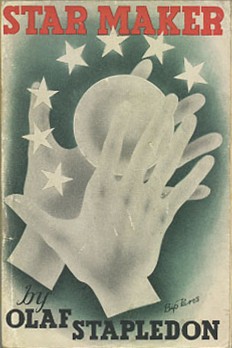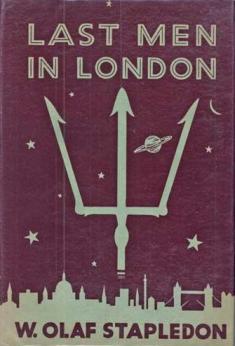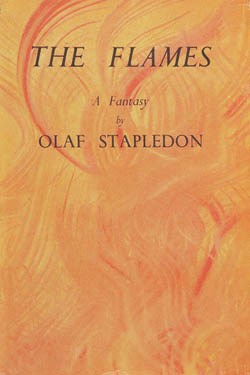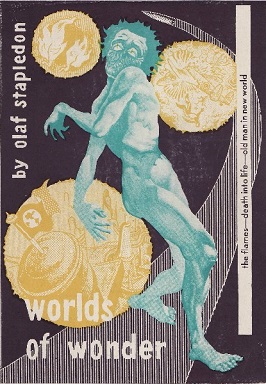
A Dyson sphere is a hypothetical megastructure that encompasses a star and captures a large percentage of its solar power output. The concept is a thought experiment that attempts to imagine how a spacefaring civilization would meet its energy requirements once those requirements exceed what can be generated from the home planet's resources alone. Because only a tiny fraction of a star's energy emissions reaches the surface of any orbiting planet, building structures encircling a star would enable a civilization to harvest far more energy.

William Olaf Stapledon was a British philosopher and author of science fiction. In 2014, he was inducted into the Science Fiction and Fantasy Hall of Fame.

Scientific romance is an archaic, mainly British term for the genre of fiction now commonly known as science fiction. The term originated in the 1850s to describe both fiction and elements of scientific writing, but it has since come to refer to the science fiction of the late nineteenth and early twentieth centuries, primarily that of Jules Verne, H. G. Wells and Arthur Conan Doyle. In recent years the term has come to be applied to science fiction written in a deliberately anachronistic style as a homage to or pastiche of the original scientific romances.

Star Maker is a science fiction novel by British writer Olaf Stapledon, published in 1937. Continuing the theme of the author's previous book, Last and First Men (1930)—which narrated a history of the human species over two billion years—it describes a history of life in the universe, dwarfing the scale of the earlier work. Star Maker tackles philosophical themes such as the essence of life, of birth, decay and death, and the relationship between creation and creator. A pervading theme is that of progressive unity within and between different civilisations.

Nicolas Camille Flammarion FRAS was a French astronomer and author. He was a prolific author of more than fifty titles, including popular science works about astronomy, several notable early science fiction novels, and works on psychical research and related topics. He also published the magazine L'Astronomie, starting in 1882. He maintained a private observatory at Juvisy-sur-Orge, France.

Last and First Men: A Story of the Near and Far Future is a "future history" science fiction novel written in 1930 by the British author Olaf Stapledon. A work of unprecedented scale in the genre, it describes the history of humanity from the present onwards across two billion years and eighteen distinct human species, of which our own is the first. The book employs a narrative conceit that, under subtle inspiration, the novelist has unknowingly been dictated a channelled text from the last human species.

Sirius is a 1944 science fiction novel by the British philosopher and author Olaf Stapledon, whose title character is a dog named Sirius with humanlike intelligence. A sense of existential questioning suffuses the book, as the author delves into aspects of Sirius's psyche. The novel deals with many human issues through Sirius and his experiences, his unusual nature, his ideas and his relationships with humans. The characters go to great lengths to prevent Sirius from becoming a circus-type wonderdog, and instead, they seek to develop Sirius's character much like a family would create and foster that of a human child.
In science fiction, uplift is a developmental process to transform a certain species of animals into more intelligent beings by other, already-intelligent beings. This is usually accomplished by cultural, technological, or evolutional interventions like genetic engineering. The earliest appearance of the concept is in H. G. Wells's 1896 novel The Island of Doctor Moreau. The term was popularized by David Brin in his Uplift series in the 1980s.

Last Men in London (1932) is a science fiction novel by British writer Olaf Stapledon.
Galaxy novels, sometimes titled Galaxy Science Fiction Novels, were a series of mostly reprint American science fiction novels published between 1950 and 1961.

Neptune has appeared in fiction since shortly after its 1846 discovery, albeit infrequently. It initially made appearances indirectly—e.g. through its inhabitants—rather than as a setting. The earliest stories set on Neptune itself portrayed it as a rocky planet rather than as having its actual gaseous composition; later works rectified this error. Extraterrestrial life on Neptune is uncommon in fiction, though the exceptions have ranged from humanoids to gaseous lifeforms. Neptune's largest moon Triton has also appeared in fiction, especially in the late 20th century onwards.

Peculiar Lives is the seventh in the series of Time Hunter novellas and features the characters Honoré Lechasseur and Emily Blandish from Daniel O'Mahony's Doctor Who novella The Cabinet of Light. It is written by Philip Purser-Hallard, author of the Mad Norwegian Press Faction Paradox novel Of the City of the Saved...

Darkness and the Light (1942) is a science fiction novel by British writer Olaf Stapledon.
Four Encounters is an unfinished work by the writer and philosopher Olaf Stapledon, written in the late 1940s but only published by Bran's Head Books in 1976, 26 years after the author's death. This edition contained an introduction by Brian Aldiss, a longtime champion of Stapledon's works. The text is also available in compilations of the author's writings.

The Flames is a science fiction novella by British writer and philosopher Olaf Stapledon. It was published by Secker and Warburg in 1947.

Nebula Maker is a science fiction novel by Olaf Stapledon and published posthumously by Bran's Head Books in 1976. It was written in the 1930s and discovered in 1976. It appears that this novel was written between his other books; Last and First Men in 1930, and Star Maker in 1937.
Fantasy Publishing Company, Inc., or FPCI, was an American science fiction and fantasy small press specialty publishing company established in 1946. It was the fourth small press company founded by William L. Crawford.

Worlds of Wonder is a collection of three science fiction works by Olaf Stapledon: a short novel, a novella and a short story. It was published in 1949 by Fantasy Publishing Company, Inc. in an edition of 500 copies. All of the stories had originally been published in the United Kingdom.
Saints and Revolutionaries is a non-fiction work by the writer and philosopher Olaf Stapledon, published by Heinemann in 1939.
Vast is a science fiction novel by Linda Nagata, part of her loosely connected "Nanotech Succession" sequence.














